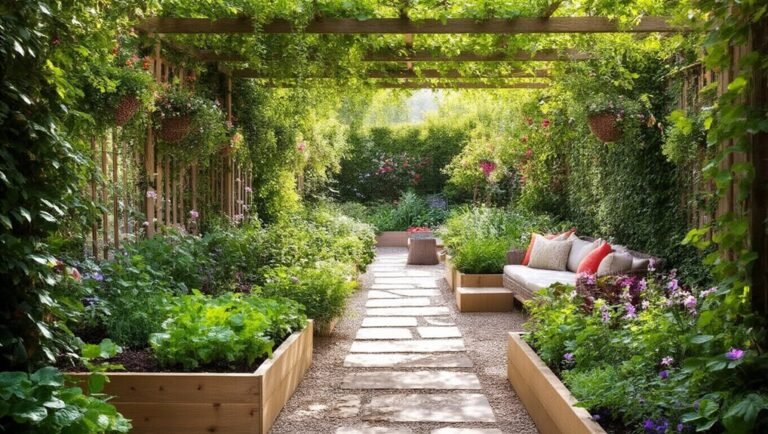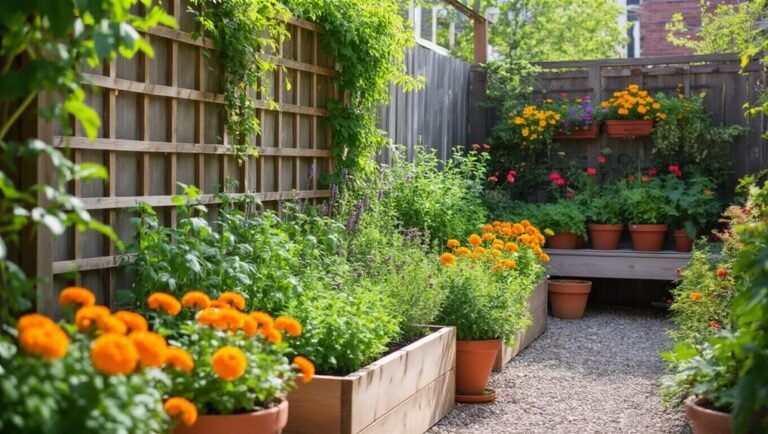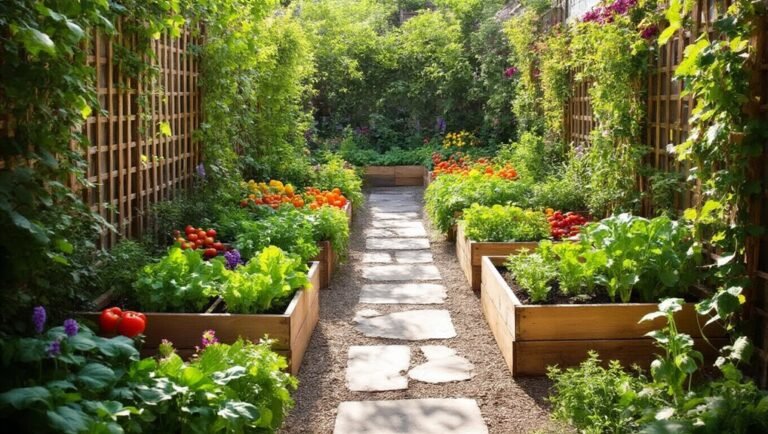To plan a backyard orchard, start by assessing your space and climate, ensuring you have full sun and well-draining soil. Choose fruit trees suited to your region and consider planting dwarf varieties if space is tight. Organize your layout for sunlight access and maintenance. Prepare your soil by tilling and adding compost, then select appropriate watering and fertilizing techniques. With the right care, you’ll enjoy a bountiful harvest. There’s plenty more to explore on how to make your orchard thrive.
Key Takeaways
- Assess your space for sunlight, soil type, and climate to choose suitable fruit trees.
- Select a variety of fruit trees that thrive in your area and consider pollination needs.
- Plan your orchard layout by spacing trees according to their mature size and grouping similar varieties.
- Prepare the soil with organic amendments and ensure proper drainage for healthy root growth.
- Implement watering techniques and seasonal maintenance to promote tree health and maximize fruit yield.
Assessing Your Space and Climate
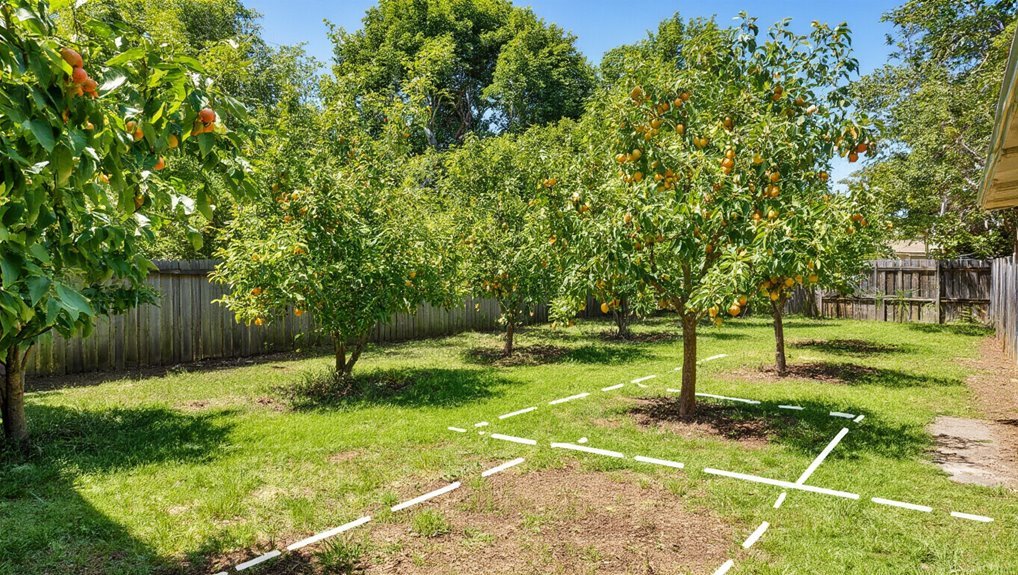
Before you dig into planting your backyard orchard, it’s crucial to assess your space and climate.
Start by observing how much sunlight your yard receives throughout the day. Most fruit trees thrive in full sun, so identify the sunniest spots.
Next, consider the soil type; well-draining soil is essential for healthy root growth. You might want to test your soil’s pH and nutrient levels to determine if amendments are needed. Mulch can also provide significant benefits by helping to retain soil moisture and suppress weeds around your fruit trees.
Also, take note of any potential obstacles, like nearby buildings or trees that could cast shade.
Lastly, evaluate your local climate, including temperature ranges and frost dates. This understanding helps you choose the best location for your orchard and ensures your fruit trees will flourish.
For optimal results, consider using the best garden soil to provide your fruit trees with the nutrients and structure they need to thrive.
Choosing the Right Fruit Trees
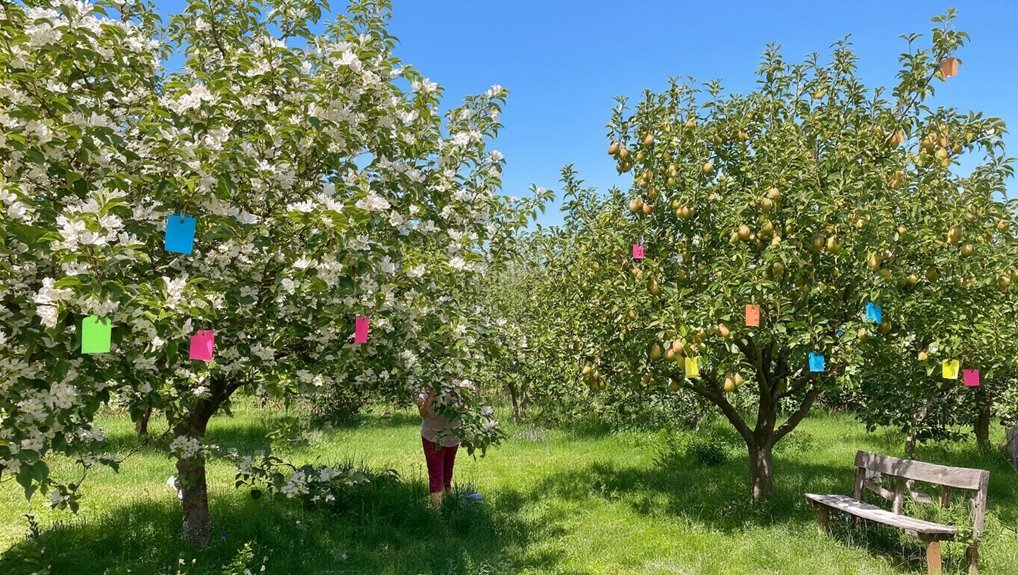
When selecting fruit trees for your backyard orchard, it’s important to consider factors like your climate, space, and personal preferences.
Start by researching which trees thrive in your area. For instance, apple trees love cooler climates, while citrus trees prefer warmer regions. Using Compost Tumblers can help you create rich organic material to boost the soil quality around your new trees.
Next, think about the space you have available. Dwarf varieties can fit well in smaller yards, while standard trees need more room to grow.
Additionally, consider your taste—do you want sweet apples, tangy cherries, or juicy peaches?
It’s also wise to choose a mix of varieties to extend your harvest season.
Lastly, check the pollination requirements; some trees need a partner to produce fruit.
Making informed choices will lead to a fruitful and satisfying orchard experience.
To support healthy fruit tree growth, consider using compost bins to produce nutrient-rich compost for your garden soil.
Planning Your Orchard Layout
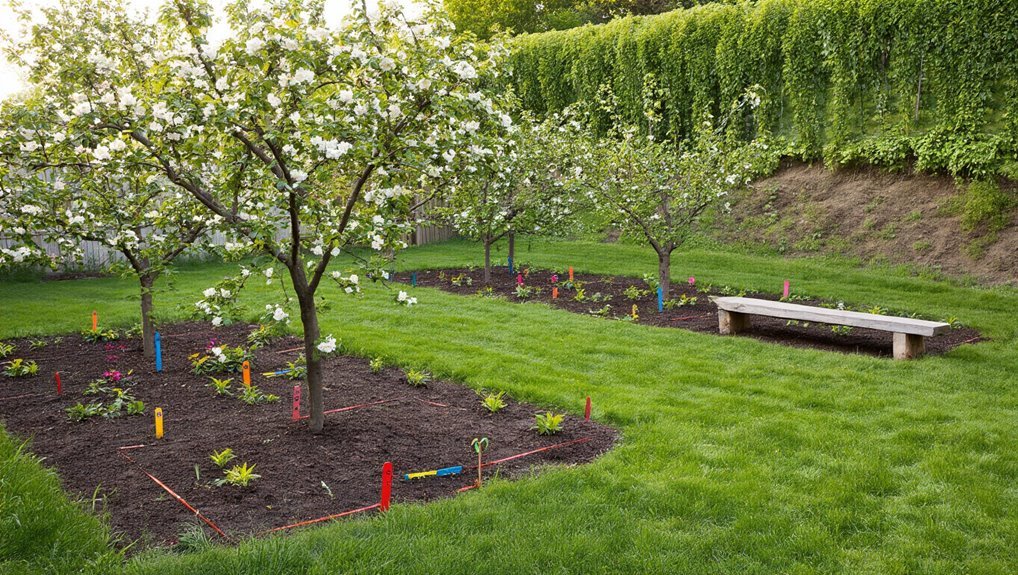
As you start planning your orchard layout, envision how each tree will fit into your space and complement one another. Consider the mature size of each tree, ensuring you allow enough room for growth.
Group similar trees together, as this can simplify care and promote cross-pollination. Think about sunlight; position taller trees to the north or west, so they don’t shade shorter ones. Incorporate pathways for easy access and maintenance, and leave space for walking between rows. Staying organized with a gardening journal can help you track your layout and planting details for future reference.
Don’t forget about seasonal changes; plan for airflow to reduce disease risk. Finally, visualize how your orchard will look throughout the year, and create a harmonious design that enhances your backyard while providing plenty of delicious fruit.
If you’re looking for more inspiration or practical advice, many gardening books offer detailed guidance on designing and maintaining productive orchards.
Preparing the Soil for Planting
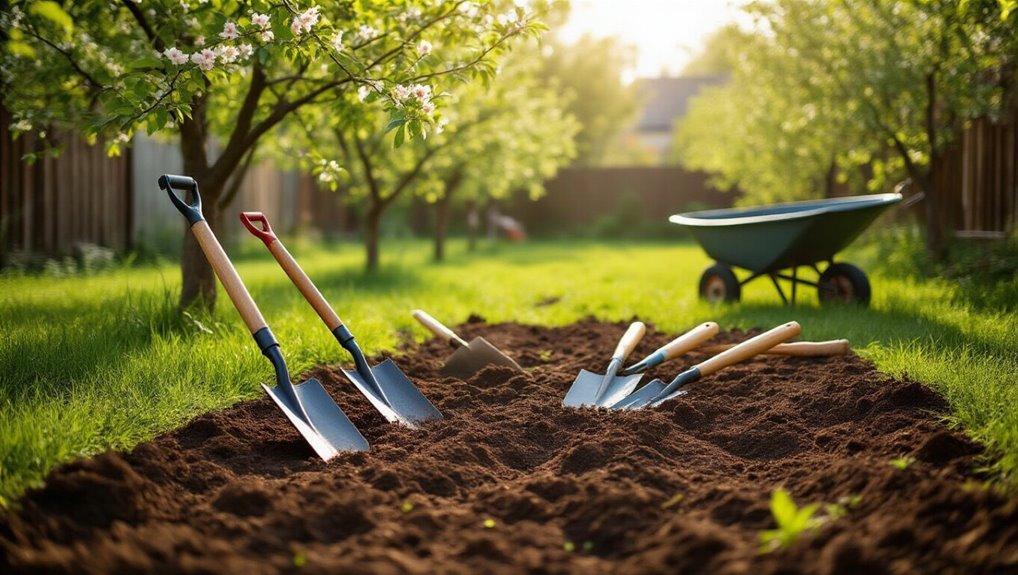
Preparing the soil for your orchard is crucial for healthy tree growth and fruitful harvests. Start by selecting a well-draining site that gets plenty of sunlight.
Test your soil’s pH and nutrient levels, aiming for a pH between 6.0 and 7.0. Amend the soil with organic matter like compost to improve fertility and drainage. If your soil is heavy clay or sandy, consider adding peat moss or aged manure to enhance its structure. You can monitor the temperature of your compost with a compost thermometer to ensure it is breaking down properly and providing optimal nutrients for your trees.
Remove any weeds, rocks, or debris to create a clean planting area. Tilling the soil to a depth of about 12 inches will help aerate it and encourage root growth.
For added benefits, consider using organic mulching materials such as straw to help retain moisture, suppress weeds, and improve soil health. Finally, give the soil a chance to settle before you start planting your trees.
Planting Your Trees
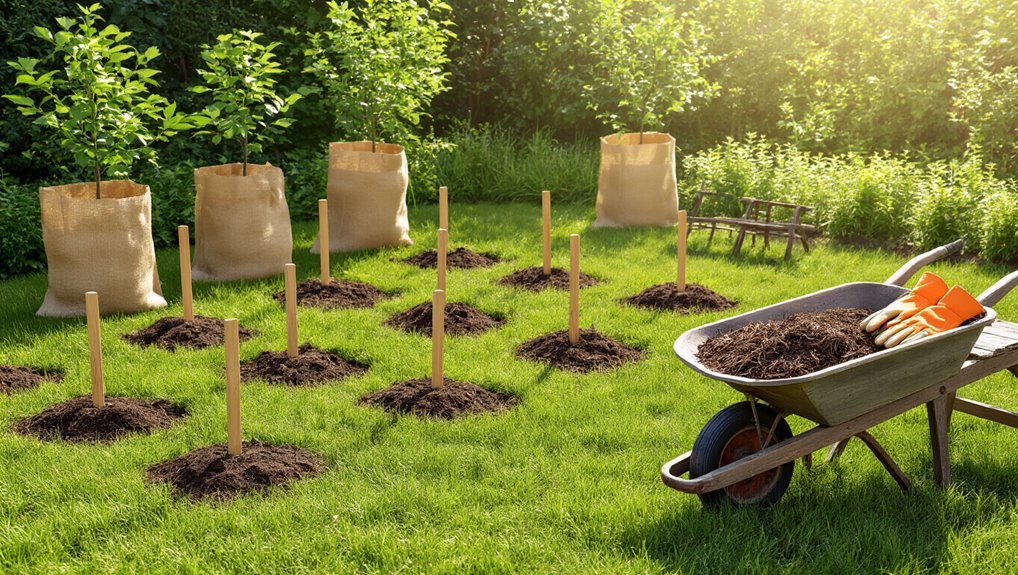
Once you’ve settled the soil, it’s time to plant your trees in the ideal spots you’ve chosen.
Start by digging a hole twice the width of the root ball and just as deep. This gives the roots room to spread and establish themselves.
Remove the tree from its container, gently loosening any tightly bound roots. Place the tree in the center of the hole, ensuring the graft union is above soil level.
Backfill with soil, pressing lightly to eliminate air pockets. Water the tree thoroughly after planting to settle the soil.
Finally, add a layer of mulch around the base to retain moisture and suppress weeds. Make sure to keep the area clear for easy maintenance and growth.
Your orchard journey is underway!
Watering and Fertilizing Techniques
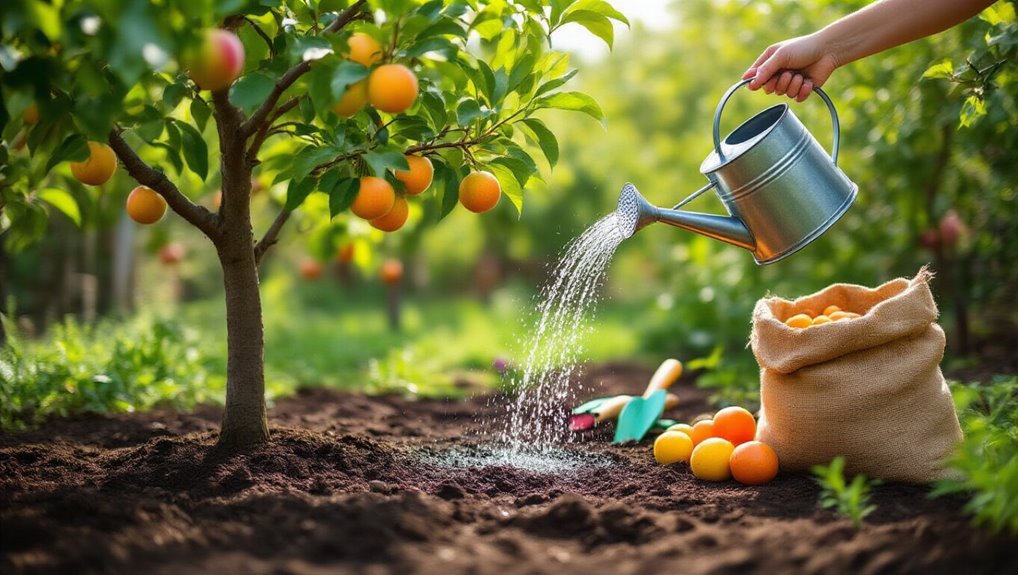
Watering and fertilizing your young trees is crucial for their health and growth. Ensure that your trees receive adequate water, especially during dry spells. A deep watering once a week is often ideal, depending on your soil type.
For fertilizing, use a balanced fertilizer in early spring to promote strong growth. Follow the recommended dosage on the package, as over-fertilizing can harm your trees.
Here’s a quick reference table for watering and fertilizing:
| Task | Frequency |
|---|---|
| Watering | Weekly (deep soak) |
| Fertilizing | Early spring |
| Check soil moisture | Every 2-3 days |
| Adjust for rainfall | As needed |
| Mulch application | Once in spring |
Pruning and Maintenance Practices
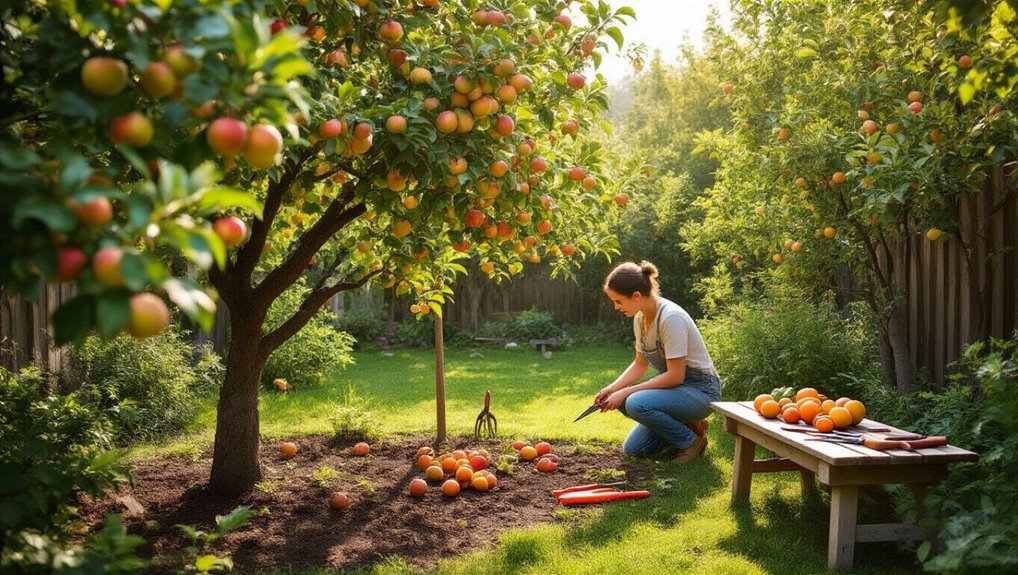
Although it might seem daunting at first, pruning and maintaining your backyard orchard is essential for the health and productivity of your trees.
Start by pruning in late winter or early spring when trees are dormant. Remove dead, damaged, or crossing branches to improve air circulation and sunlight penetration. Aim for an open center shape for better light exposure.
Regularly check for pests and diseases, and address any issues promptly. Mulching around the base helps retain moisture and suppress weeds.
Don’t forget to water your trees during dry spells, especially in their first few years. Lastly, consider fertilizing annually to provide essential nutrients.
With consistent care, your orchard will thrive and reward you with bountiful fruit.
Harvesting and Enjoying Your Fruit
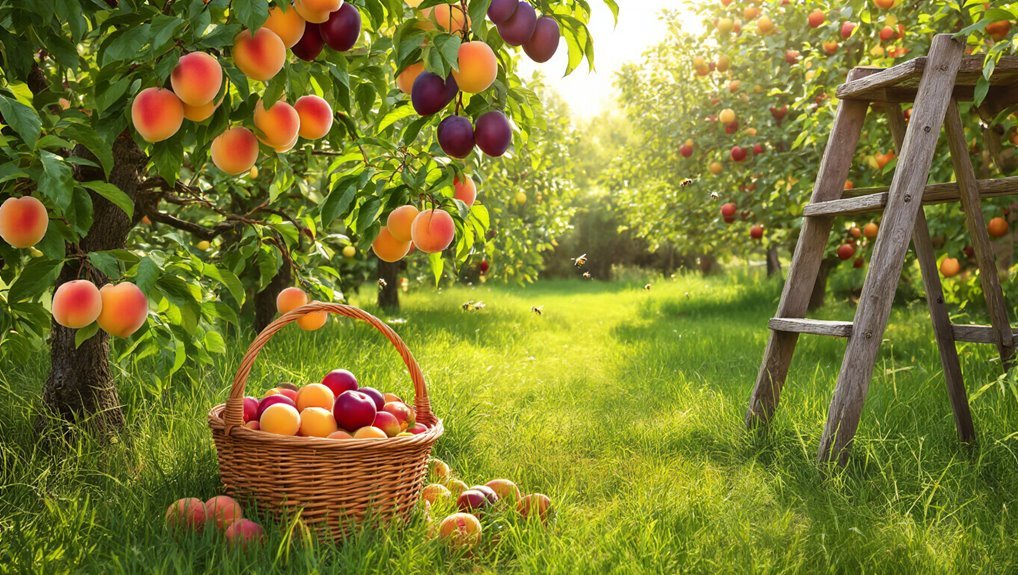
After you’ve invested time in pruning and maintaining your orchard, the moment of harvest brings its own excitement. You’ll want to pick your fruit at the right time for optimal flavor and freshness. Gently twist or cut the fruit from the tree to avoid damaging the branches.
Here’s a quick guide to help you know when to harvest:
| Fruit Type | Harvest Time |
|---|---|
| Apples | Late summer to fall |
| Peaches | Summer, when slightly soft |
| Pears | Late summer to fall, when they start to yellow |
Once harvested, enjoy your fresh fruit right away or preserve them for later. Share with friends and family to celebrate your hard work!
Frequently Asked Questions
How Long Does It Take for Fruit Trees to Bear Fruit?
Fruit trees typically take anywhere from three to six years to bear fruit, depending on the type. Patience is key, but once they start producing, you’ll enjoy delicious harvests for years to come!
Can I Grow Fruit Trees in Containers?
Yes, you can definitely grow fruit trees in containers! Just choose dwarf varieties, ensure proper drainage, and use quality potting soil. Regular watering and fertilizing will help your trees thrive and produce delicious fruit.
What Pests Should I Watch Out For?
When it comes to pests, you’ve got to keep your eyes peeled. Watch out for aphids, spider mites, and fruit flies. They can wreak havoc on your trees if you don’t take action quickly.
How Do I Know When to Pick My Fruit?
To know when to pick your fruit, observe its color, size, and firmness. Check for a pleasant aroma and taste a sample. Each fruit variety has specific indicators, so research your particular types for best results.
Are There Any Companion Plants for Fruit Trees?
Yes, companion plants like marigolds, clover, and comfrey can benefit your fruit trees. They attract beneficial insects, improve soil health, and enhance pollination. Mixing them with your trees creates a more vibrant and productive garden ecosystem.
Conclusion
Now that you’ve mastered the art of backyard orcharding, get ready for a fruit explosion that’ll make grocery stores weep! Picture yourself basking in the glory of your bountiful harvest, devouring peaches so juicy they practically sing, and apples so crisp they’ll make your neighbors green with envy. With a little care and creativity, your backyard will transform into a paradise of flavor that’ll have everyone clamoring for a taste. So dig in, and let the fruit frenzy begin!
